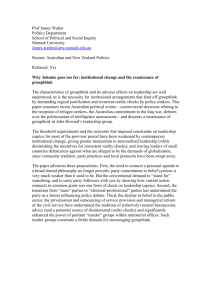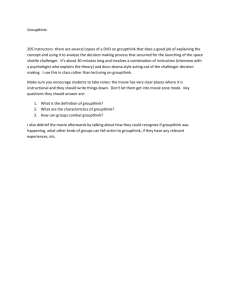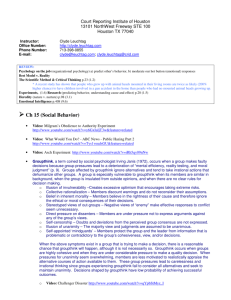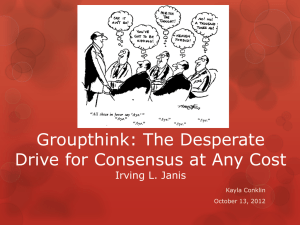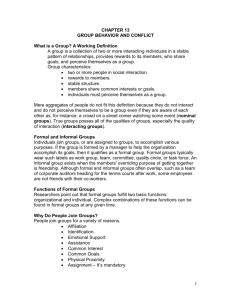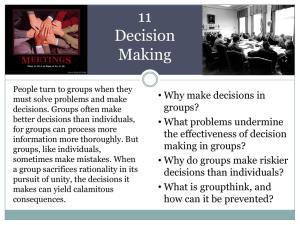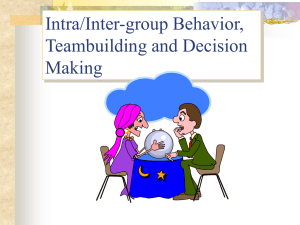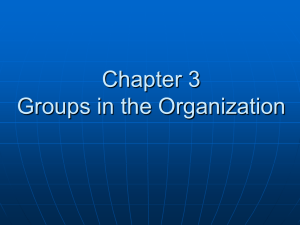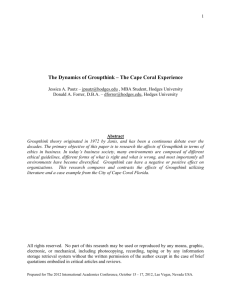Business Decision-Making and Groupthink
advertisement
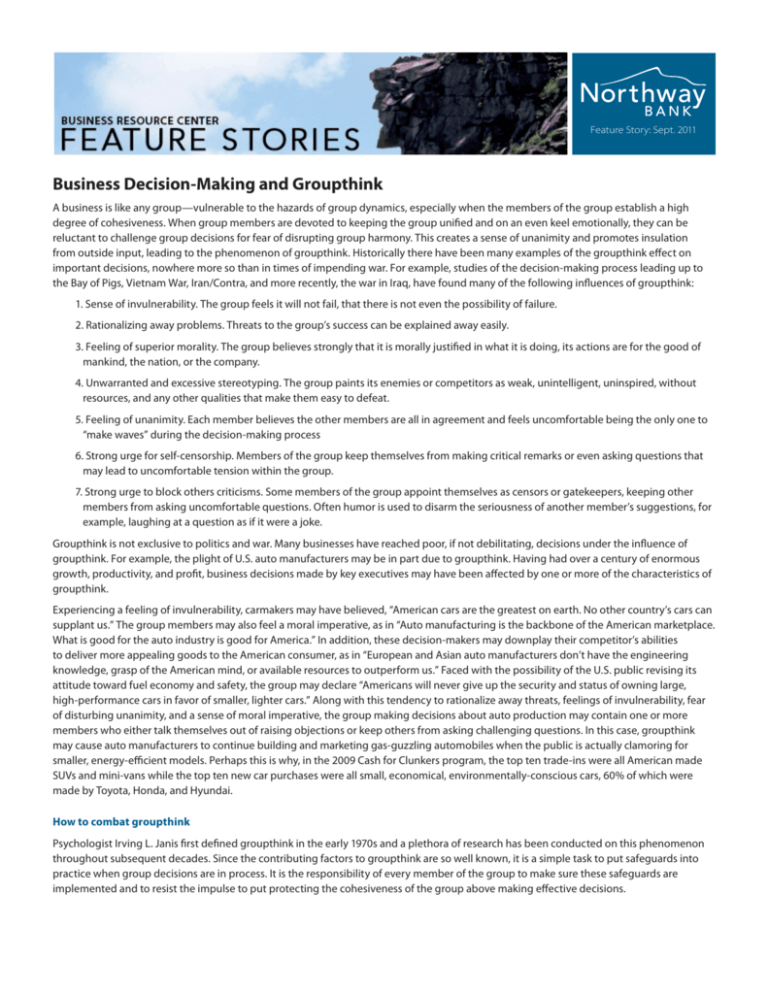
Feature Story: Sept. 2011 Business Decision-Making and Groupthink A business is like any group—vulnerable to the hazards of group dynamics, especially when the members of the group establish a high degree of cohesiveness. When group members are devoted to keeping the group unified and on an even keel emotionally, they can be reluctant to challenge group decisions for fear of disrupting group harmony. This creates a sense of unanimity and promotes insulation from outside input, leading to the phenomenon of groupthink. Historically there have been many examples of the groupthink effect on important decisions, nowhere more so than in times of impending war. For example, studies of the decision-making process leading up to the Bay of Pigs, Vietnam War, Iran/Contra, and more recently, the war in Iraq, have found many of the following influences of groupthink: 1. Sense of invulnerability. The group feels it will not fail, that there is not even the possibility of failure. 2. Rationalizing away problems. Threats to the group’s success can be explained away easily. 3. Feeling of superior morality. The group believes strongly that it is morally justified in what it is doing, its actions are for the good of mankind, the nation, or the company. 4. Unwarranted and excessive stereotyping. The group paints its enemies or competitors as weak, unintelligent, uninspired, without resources, and any other qualities that make them easy to defeat. 5. Feeling of unanimity. Each member believes the other members are all in agreement and feels uncomfortable being the only one to “make waves” during the decision-making process 6. Strong urge for self-censorship. Members of the group keep themselves from making critical remarks or even asking questions that may lead to uncomfortable tension within the group. 7. Strong urge to block others criticisms. Some members of the group appoint themselves as censors or gatekeepers, keeping other members from asking uncomfortable questions. Often humor is used to disarm the seriousness of another member’s suggestions, for example, laughing at a question as if it were a joke. Groupthink is not exclusive to politics and war. Many businesses have reached poor, if not debilitating, decisions under the influence of groupthink. For example, the plight of U.S. auto manufacturers may be in part due to groupthink. Having had over a century of enormous growth, productivity, and profit, business decisions made by key executives may have been affected by one or more of the characteristics of groupthink. Experiencing a feeling of invulnerability, carmakers may have believed, “American cars are the greatest on earth. No other country’s cars can supplant us.” The group members may also feel a moral imperative, as in “Auto manufacturing is the backbone of the American marketplace. What is good for the auto industry is good for America.” In addition, these decision-makers may downplay their competitor’s abilities to deliver more appealing goods to the American consumer, as in “European and Asian auto manufacturers don’t have the engineering knowledge, grasp of the American mind, or available resources to outperform us.” Faced with the possibility of the U.S. public revising its attitude toward fuel economy and safety, the group may declare “Americans will never give up the security and status of owning large, high-performance cars in favor of smaller, lighter cars.” Along with this tendency to rationalize away threats, feelings of invulnerability, fear of disturbing unanimity, and a sense of moral imperative, the group making decisions about auto production may contain one or more members who either talk themselves out of raising objections or keep others from asking challenging questions. In this case, groupthink may cause auto manufacturers to continue building and marketing gas-guzzling automobiles when the public is actually clamoring for smaller, energy-efficient models. Perhaps this is why, in the 2009 Cash for Clunkers program, the top ten trade-ins were all American made SUVs and mini-vans while the top ten new car purchases were all small, economical, environmentally-conscious cars, 60% of which were made by Toyota, Honda, and Hyundai. How to combat groupthink Psychologist Irving L. Janis first defined groupthink in the early 1970s and a plethora of research has been conducted on this phenomenon throughout subsequent decades. Since the contributing factors to groupthink are so well known, it is a simple task to put safeguards into practice when group decisions are in process. It is the responsibility of every member of the group to make sure these safeguards are implemented and to resist the impulse to put protecting the cohesiveness of the group above making effective decisions. Some effective strategies to implement when group decision-making is required are: 1. The group leader should encourage dissenting opinions. Since one of the dangers of groupthink is that all members will reach consensus prematurely and not consider objections to the proposed plan of action, the group leader should ask for objections in a non-threatening manner and act welcoming and supportive of these objections. Fostering or even appointing a group member as “devil’s advocate” can assist in this strategy. 2. Separate the group into two groups. It is much less likely that two smaller groups considering a proposal will come up with exactly the same conclusion independently. If they do, the decision is probably a valid one, but if they don’t, the ensuing discussion over the feasibility of the two decisions will bring up points each group may not have been aware of individually. 3. Admit that the group’s decision-making abilities are imperfect. Groupthink fosters a feeling of perfection in the group. Having made successful decisions in the past, the group members may feel they are impervious to failure. In this climate, those members with objections may lack the confidence to “buck the system”. By acknowledging up-front and out loud that the group does not have perfect knowledge or decision-making skills may help some members air their misgivings or seek outside information. 4. Let the decision sit for a while. Once a decision has been made, groups vulnerable to groupthink may feel that it is set in stone. If the group has time to mull it over, flaws in the decision may come to light. Holding a “second-chance” meeting may allow previously unspoken criticisms to be voiced, providing another level of review and revision. Ultimately, a decision must be made. In business, timely decisions are often critical—but a poor decision is sometimes more devastating than no decision at all. By recognizing the characteristics of groupthink and putting strategies into place to reduce the likelihood of its influence, group decision-makers can substantially increase their rate of success.
